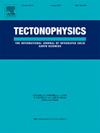Remagnetisation of the Caerfai Group (lower Cambrian, SW Wales) in hot geothermal fluids during Caledonian (pre-Acadian) metamorphism
IF 2.6
3区 地球科学
Q2 GEOCHEMISTRY & GEOPHYSICS
引用次数: 0
Abstract
Palaeomagnetic data from the Lower Cambrian red beds of the Caerfai Group in Pembrokeshire, South Wales have been revisited. Original studies all produced closely similar directional data with the combined results yielding a palaeomagnetic pole at 21.8oS; 355.5°E corresponding to a time of ∼430 Ma when compared with the APWP of Stable Europe and Baltica. The results of this study indicate that remagnetisation occurred during Caledonian metamorphism, prior to Acadian deformation in the area. The magnetic remanence is carried by fine grained hematite distributed throughout the sequence and which appears to have been acquired during the duration of a single chron. This time zone is traditional early Silurian (late Llandovery) and corresponds to the docking of Baltica and east Avalonia with the Laurentian continent. The proposed age of the remagnetisation event is consistent with radiometric ages from epizonal authigenic illites in overlying Middle Cambrian bentonites at Porth-y-Rhaw and elsewhere in the Welsh Basin and other parts of Avalonia including Charnwood block and Brabantia. The Caerfai Group comprises texturally immature litharenites with a mineral assemblage including chlorite, biotite, muscovite, graphite, and epidote consistent with a greenschist facies source area which remains unidentified. A key component of the Caerfai mineral assemblage are magnetite crystals (typically 30–60 μm) deposited during contemporaneous volcanic activity. Deep burial during the drift of Avalonia, indicated by clay transformations and overpressure in the Caerfai Bay Mudstone, was associated with the alteration of iron-bearing minerals and the dissolution of magnetite. During collision of Avalonia/Baltica with Laurentia a geothermal cell with epizonal metamorphic conditions (>300 °C) and fluids enriched in iron, probably in the form of iron chloride complexes was established. The remagnetisation event was triggered when the geothermal cell was cooled, most likely by the infiltration of meteoric water, and the reaction of iron chloride with water produced the widespread precipitation of fine-grained hematite and the formation of a chemical remanent magnetisation (CRM).
在喀里多尼亚(前阿卡迪亚)变质过程中,热地热流体对 Caerfai 组(下寒武统,威尔士西南部)的重磁作用
我们重新研究了南威尔士彭布罗克郡凯尔法伊组下寒武统红色岩床的古地磁数据。最初的研究都得出了非常相似的方向数据,综合结果得出古地磁极位于 21.8oS; 355.5°E 与稳定的欧洲和波罗的海的 APWP 相比,对应的时间为 ∼430 Ma。这项研究的结果表明,在该地区阿卡迪亚变形之前的喀里多尼亚变质过程中发生了再磁化。磁性剩磁由分布在整个序列中的细粒赤铁矿携带,似乎是在一个纪元期间获得的。该时区是传统的志留纪早期(兰德发现晚期),与波罗的海和东阿瓦隆尼亚与劳伦大陆的对接相吻合。所提出的再磁化事件的年龄与 Porth-y-Rhaw 和威尔士盆地其他地方以及阿瓦鲁尼亚其他地区(包括 Charnwood 区块和 Brabantia)上覆中寒武纪膨润土中的外生自生伊利石的放射性年龄一致。Caerfai 组由质地不成熟的石英岩组成,矿物组合包括绿泥石、黑云母、白云母、石墨和绿帘石,与绿帘石面源区一致,该源区仍未确定。凯尔法伊矿物组合的一个重要组成部分是在同期火山活动中沉积的磁铁矿晶体(通常为 30-60 μm)。阿瓦隆尼亚漂移期间的深埋(由卡埃尔费湾泥岩中的粘土转化和超压表明)与含铁矿物的蚀变和磁铁矿的溶解有关。在阿瓦鲁尼亚/波罗的海与劳伦提亚碰撞期间,建立了一个地热单元,该单元具有表层变质条件(>300 °C)和富含铁的流体,可能以氯化铁复合物的形式存在。地热池冷却时(很可能是流星水的渗入)引发了再磁化事件,氯化铁与水的反应产生了细粒赤铁矿的广泛沉淀,并形成了化学剩磁(CRM)。
本文章由计算机程序翻译,如有差异,请以英文原文为准。
求助全文
约1分钟内获得全文
求助全文
来源期刊

Tectonophysics
地学-地球化学与地球物理
CiteScore
4.90
自引率
6.90%
发文量
300
审稿时长
6 months
期刊介绍:
The prime focus of Tectonophysics will be high-impact original research and reviews in the fields of kinematics, structure, composition, and dynamics of the solid arth at all scales. Tectonophysics particularly encourages submission of papers based on the integration of a multitude of geophysical, geological, geochemical, geodynamic, and geotectonic methods
 求助内容:
求助内容: 应助结果提醒方式:
应助结果提醒方式:


